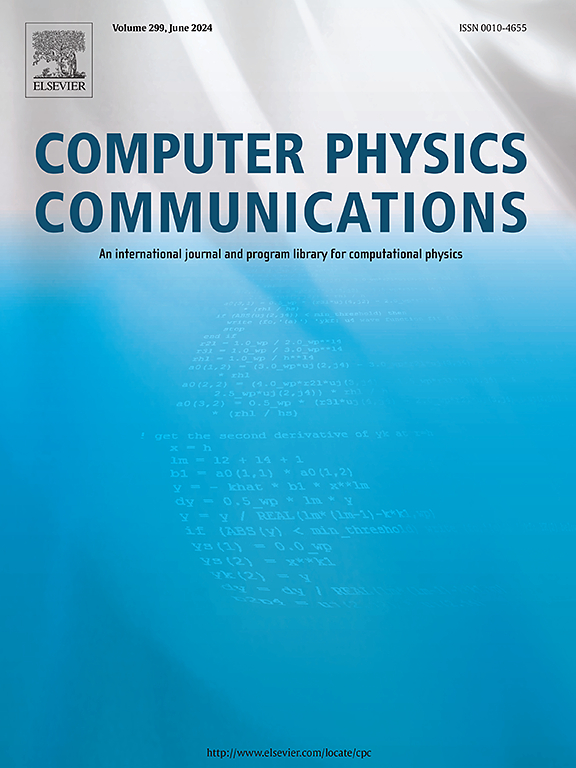一个展开电子和声子带的程序
IF 7.2
2区 物理与天体物理
Q1 COMPUTER SCIENCE, INTERDISCIPLINARY APPLICATIONS
引用次数: 0
摘要
我们介绍了一个名为KPROJ的程序,该程序展示了由超级细胞模拟的材料的电子和声子带结构。该程序基于k-投影法,将超级单体的波函数投影到人工原始细胞布里渊区的k点上。它允许通过对k投影波函数进行部分积分来获得有效的“局部”带结构,例如,对于界面具有层投影的未展开带结构和真空中的加权带结构。通过结合快速傅里叶变换(FFT)和反FFT算法的方案来加速层k投影。它现在与几个基于平面波的第一性原理代码接口,如VASP, Quantum Espresso和ABINIT。此外,它还具有与ABACUS(基于数值原子基集的第一性原理模拟包)和PHONOPY(用于声子计算的程序)的接口。程序摘要程序标题:KPROJCPC库链接到程序文件:https://doi.org/10.17632/f6n5phpy8f.1Developer's存储库链接:https://github.com/mxchen-2020/kprojLicensing条款:gplv3.0编程语言:Fortran 90问题的性质:超级细胞被广泛用于模拟掺杂系统和第一原理方法框架内的接口。然而,使用超级电池会导致带折叠,这不利于理解掺杂和界面对材料带结构的影响。此外,这种折叠也给角分辨光发射光谱实验结果的解释带来了困难。求解方法:本程序设计用于计算由超级单元模拟的系统的未展开带结构。展开是通过将超级单体的波函数投射到原始细胞BZ的k点上来完成的。投影算子由平移算子及其不可约表示构成。通过在选定的空间窗口内对投影波函数进行积分,得到k层投影波段结构,并采用FFT和逆FFT算法加速计算。本文章由计算机程序翻译,如有差异,请以英文原文为准。
KPROJ: A program for unfolding electronic and phononic bands
We introduce a program named KPROJ that unfolds the electronic and phononic band structure of materials modeled by supercells. The program is based on the k-projection method, which projects the wavefunction of the supercell onto the k-points in the Brillouin zone of the artificial primitive cell. It allows for obtaining an effective “local” band structure by performing partial integration over the k-projected wavefunctions, e.g., the unfolded band structure with layer-projection for interfaces and the weighted band structure in the vacuum for slabs. The layer k-projection is accelerated by a scheme that combines the Fast Fourier Transform (FFT) and the inverse FFT algorithms. It is now interfaced with several first-principles codes based on plane waves such as VASP, Quantum Espresso, and ABINIT. In addition, it also has interfaces with ABACUS, a first-principles simulation package based on numerical atomic basis sets, and PHONOPY, a program for phonon calculations.
Program summary
Program Title: KPROJ
CPC Library link to program files: https://doi.org/10.17632/f6n5phpy8f.1
Developer's repository link: https://github.com/mxchen-2020/kproj
Licensing provisions: GPLv3.0
Programming language: Fortran 90
Nature of problem: Supercells are widely used to model doped systems and interfaces within the framework of first-principles methods. However, the use of supercells causes band folding, which is unfavorable for understanding the effects of doping and interfacing on the band structure of materials. Moreover, the folding also brings difficulties in explaining the results of angle-resolved photoemission spectroscopy experiments.
Solution method: This program is designed to calculate the unfolded band structure for systems modeled by supercells. The unfolding is performed by projecting the wave functions of the supercell onto the k-points in the BZ of the primitive cell. The projector operator is built by the translation operator and its irreducible representation. The layer k-projected band structure is obtained by integrating the projected wave function in a selected spatial window, for which the FFT and inverse FFT algorithms are used to accelerate the calculation.
求助全文
通过发布文献求助,成功后即可免费获取论文全文。
去求助
来源期刊

Computer Physics Communications
物理-计算机:跨学科应用
CiteScore
12.10
自引率
3.20%
发文量
287
审稿时长
5.3 months
期刊介绍:
The focus of CPC is on contemporary computational methods and techniques and their implementation, the effectiveness of which will normally be evidenced by the author(s) within the context of a substantive problem in physics. Within this setting CPC publishes two types of paper.
Computer Programs in Physics (CPiP)
These papers describe significant computer programs to be archived in the CPC Program Library which is held in the Mendeley Data repository. The submitted software must be covered by an approved open source licence. Papers and associated computer programs that address a problem of contemporary interest in physics that cannot be solved by current software are particularly encouraged.
Computational Physics Papers (CP)
These are research papers in, but are not limited to, the following themes across computational physics and related disciplines.
mathematical and numerical methods and algorithms;
computational models including those associated with the design, control and analysis of experiments; and
algebraic computation.
Each will normally include software implementation and performance details. The software implementation should, ideally, be available via GitHub, Zenodo or an institutional repository.In addition, research papers on the impact of advanced computer architecture and special purpose computers on computing in the physical sciences and software topics related to, and of importance in, the physical sciences may be considered.
 求助内容:
求助内容: 应助结果提醒方式:
应助结果提醒方式:


